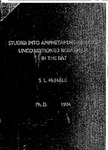Studies into Amphetamine-Induced Unconditioned Behaviour in the Rat.
| dc.contributor.author | McHale, Susan Lesley | |
| dc.contributor.other | School of Psychology | en_US |
| dc.date.accessioned | 2012-08-02T08:33:23Z | |
| dc.date.available | 2012-08-02T08:33:23Z | |
| dc.date.issued | 1994 | |
| dc.identifier | Not available | en_US |
| dc.identifier.uri | http://hdl.handle.net/10026.1/1071 | |
| dc.description.abstract |
Previous work on the unconditioned effects of amphetamine in rats has examined qualitative changes in behaviours which become stereotyped and quantitative changes in locomotion. Stereotyped behaviours have been adopted as a model of raised caudate-putameri function whilst locomotion has been adopted as a model of raised mesolimbic dopamine function. These models have been used to study drugs which are effective in the treatment of schizophrenia. Only locomotion is reliably antagonised by all classes of antipsychotic drugs, although it has been hypothesised that, under some doses of amphetamine, locomotion may also become stereotyped. The Lyon-Robbins hypothesis of the behavioural effects of amphetamine predicts competition between the output of the mesolimbic and caudate-putamen, and would predict that stereotyped locomotion represents a 'blending' of mesolimbic and caudate-putamen behavioural output. An experiment was conducted to test the Lyon-Robbins hypothesis using contrast-based image analysis to determine the spatio-temporal characteristics of open-field locomotion. A further four experiments examined the effects of a classic antipsychotic (haloperidol), the atypical antipsychotics (clozapine and sulpiride) and a putative antipsychotic (a 5-HT3 antagonist, ondansetron) on open-field locomotor routes taken by rats following treatment with 3.5mg/kg amphetamine. Measures of stereotyped locomotion derived from image analysis were supported by a novel form of behavioural analysis based on multi-dimensional scaling which provided an integrated analysis of behavioural change following drug treatment. Haloperidol blocked locomotion and stereotyped behaviours including stereotyped locomotion, whereas clozapine, sulpiride and ondansetron blocked locomotion but not stereotyped locomotion and in some cases increased stereotyped behaviours. This suggests that stereotyped locomotion represents synergistic functioning of both mesolimbic and caudate-putamen systems, when the output from the caudate-putamen is insufficient to over-ride that of the mesolimbic system. Antagonism of a 5-HT3 enhancement of mesolimbic locomotor activity by ondansetron allowed latent 5-HT and dopamine mediated behaviours to be expressed. This effectively mimicked a leftwards shift of the amphetamine dose response curve, hypothesised as amplification of the caudate-putamen output. These findings lend support to the Lyon-Robbins hypothesis of the behavioural effects of amphetamine. | en_US |
| dc.language.iso | en | en_US |
| dc.publisher | University of Plymouth | en_US |
| dc.title | Studies into Amphetamine-Induced Unconditioned Behaviour in the Rat. | en_US |
| dc.type | Thesis | |
| dc.identifier.doi | http://dx.doi.org/10.24382/1623 | |
| dc.identifier.doi | http://dx.doi.org/10.24382/1623 |
Files in this item
This item appears in the following Collection(s)
-
01 Research Theses Main Collection
Research Theses Main


